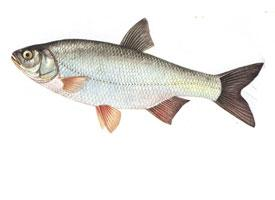
Váhy a míry
| Délka | 90 cm |
|---|---|
| Hmotnost | od 8 do 12 kg |
Popis zvířete
The Black carp, scientifically named Mylopharyngodon piceus, is a species of freshwater fish that belongs to the Cyprinidae family, which is notable for comprising various carp species. Native to the major rivers and lakes of East Asia, particularly in countries such as China and Vietnam, the Black carp has both fascinated and concerned biologists and conservationists alike due to its unique ecological role and potential as an invasive species.Physically, the Black carp is a robust and elongated fish, capable of reaching significant lengths of up to 35 inches (90 cm) or more, and weights that can exceed 70 pounds (32 kg). Its body is predominantly dark, varying from shades of grey to almost black, which is the characteristic feature that lends the species its common name. The fish's scales are large and its mouth is slightly subterminal, adapted for its bottom-dwelling lifestyle.
One of the most distinctive aspects of the Black carp's biology is its diet, which primarily consists of mollusks, including snails and mussels. This preference makes the Black carp a natural biocontrol agent against pest species of mollusks, which can be beneficial in certain aquaculture settings. However, this same dietary preference has also led to significant ecological concerns where the Black carp has been introduced outside its native range. In environments not adapted to its presence, the Black carp can decimate local populations of mollusks, some of which may be endangered or play critical roles in the ecosystem's health.
The Black carp's reproductive habits are similarly noteworthy. The species is known for its migratory spawning behavior, requiring large, flowing waters to reproduce successfully. Spawning typically occurs in the spring and early summer when water temperatures reach around 18 to 20°C (64 to 68°F). Like many other carp species, the Black carp lays a large number of eggs, which are fertilized externally and then left to develop without parental care. The larvae are initially planktonic, drifting downstream until they are large enough to fend for themselves.
The introduction of Black carp into non-native environments, often for the purpose of controlling snail populations in aquaculture, has led to the species being classified as invasive in several regions, including parts of the United States. Concerns about the Black carp's impact on native mollusk populations and the broader ecosystem have prompted various management and control efforts aimed at preventing its spread and mitigating its impact.
Conservationists and fisheries managers face a complex challenge with the Black carp. On one hand, its abilities as a biocontrol agent can be harnessed for economic benefit and for the management of pest species. On the other hand, the need to protect native ecosystems from its potentially destructive feeding habits requires careful oversight and management. Balancing these needs continues to be a focus of ongoing research and policy development in regions where the Black carp is found.
In summary, the Black carp (Mylopharyngodon piceus) is a fascinating species with significant ecological, economic, and conservation implications. Its unique characteristics and behaviors have made it a subject of interest across various fields, from aquaculture to environmental science, highlighting the complex interactions between species and their environments.
Podobná zvířata
Nové fotografie zvířat
Top 10 zvířat
- Dolphin gull (Leucophaeus scoresbii)
- Diana monkey (Cercopithecus diana)
- Moustached guenon (Cercopithecus cephus)
- Galápagos tortoise (Geochelone nigra complex)
- Stone loach (Barbatula barbatula)
- Japanese macaque (Macaca fuscata)
- Russian tortoise (Testudo horsfieldii)
- Greek tortoise (Testudo graeca)
- Common flying dragon (Draco volans)
- Vendace (Coregonus albula)


